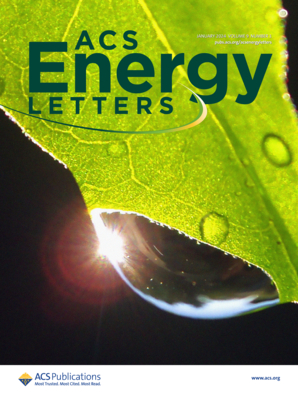实现全固态电池中稳定电解质-电极界面的化学路线图
IF 19.3
1区 材料科学
Q1 CHEMISTRY, PHYSICAL
引用次数: 0
摘要
与传统锂离子电池相比,全固态电池(ASSB)在提高安全性、能量密度和功率密度方面大有可为。然而,由于电极和固态电解质之间的界面反应性导致的电阻增长和电池性能降低,阻碍了它们的发展。全面了解界面反应和有效的缓解策略对于释放 ASSB 的潜力至关重要。在此,我们引入了稳定性网络的概念,将锂和非锂化合物之间的化学和电化学反应编码在一个全面而复杂的网络结构中。通过分析稳定性网络的拓扑结构,我们揭示了在不同电化学条件下两相反应和平衡的有组织和化学指导性模式。这种对与成分、化学和电化学变量相关的内在模式的理解,为界面的实验设计和工程学提供了一套原则,是实现 ASSB 中稳定的电解质-电极界面的化学路线图。本文章由计算机程序翻译,如有差异,请以英文原文为准。

Chemical Roadmap toward Stable Electrolyte–Electrode Interfaces in All-Solid-State Batteries
All-solid-state batteries (ASSBs) hold significant promise for enhanced safety, energy density, and power density compared to conventional lithium-ion batteries. However, their development is impeded by the growth of resistance and diminished cell performance due to the interfacial reactivity between the electrodes and solid-state electrolytes. Comprehensive knowledge of interface reactions and effective mitigation strategies are essential to unlock the potential of ASSBs. Herein, we introduce the concept of a stability network to encode chemical and electrochemical reactions among lithium and non-lithium compounds within a comprehensive and complex network structure. Through analyzing the topological structure of the stability network, we reveal an organized and chemically instructive pattern of two-phase reactions and equilibria under different electrochemical conditions. This understanding of intrinsic patterns in relation to compositional, chemical, and electrochemical variables offers a set of principles for the experimental design and engineering of interfaces, serving as a chemical roadmap for achieving stable electrolyte–electrode interfaces in ASSBs.
求助全文
通过发布文献求助,成功后即可免费获取论文全文。
去求助
来源期刊

ACS Energy Letters
Energy-Renewable Energy, Sustainability and the Environment
CiteScore
31.20
自引率
5.00%
发文量
469
审稿时长
1 months
期刊介绍:
ACS Energy Letters is a monthly journal that publishes papers reporting new scientific advances in energy research. The journal focuses on topics that are of interest to scientists working in the fundamental and applied sciences. Rapid publication is a central criterion for acceptance, and the journal is known for its quick publication times, with an average of 4-6 weeks from submission to web publication in As Soon As Publishable format.
ACS Energy Letters is ranked as the number one journal in the Web of Science Electrochemistry category. It also ranks within the top 10 journals for Physical Chemistry, Energy & Fuels, and Nanoscience & Nanotechnology.
The journal offers several types of articles, including Letters, Energy Express, Perspectives, Reviews, Editorials, Viewpoints and Energy Focus. Additionally, authors have the option to submit videos that summarize or support the information presented in a Perspective or Review article, which can be highlighted on the journal's website. ACS Energy Letters is abstracted and indexed in Chemical Abstracts Service/SciFinder, EBSCO-summon, PubMed, Web of Science, Scopus and Portico.
 求助内容:
求助内容: 应助结果提醒方式:
应助结果提醒方式:


